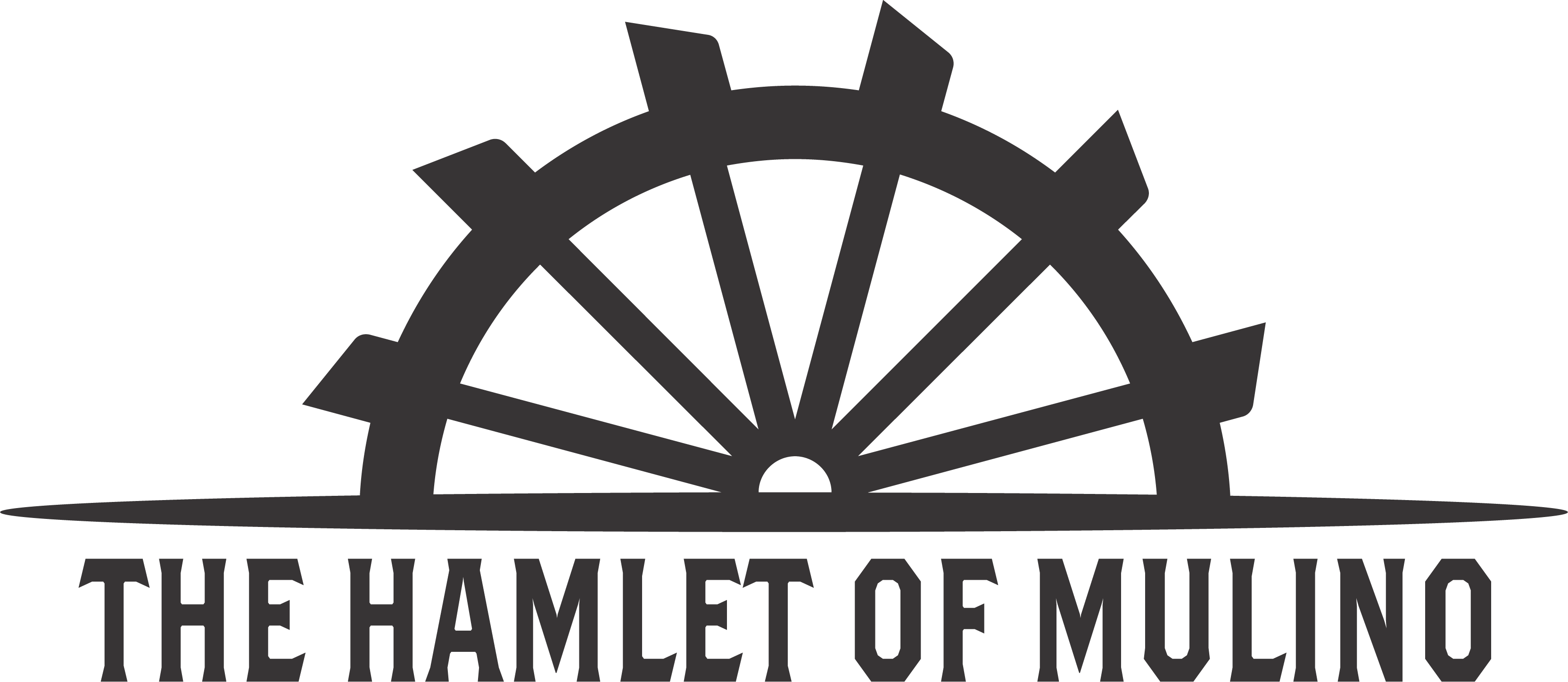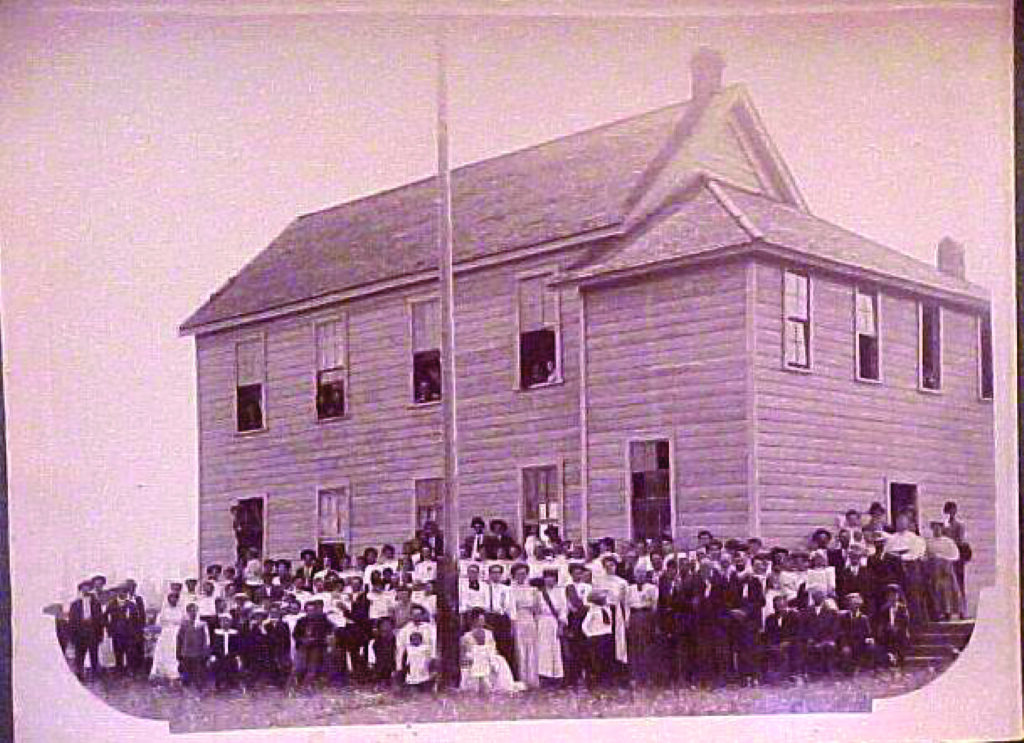
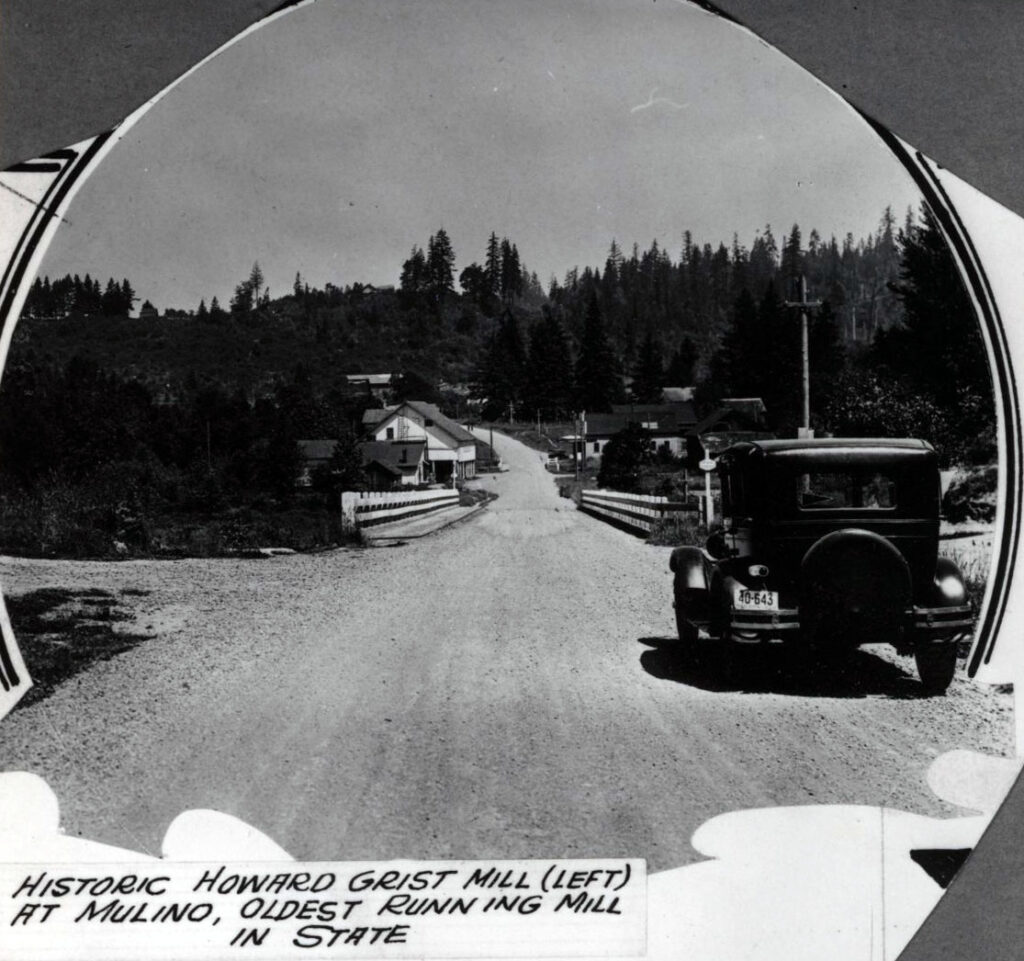
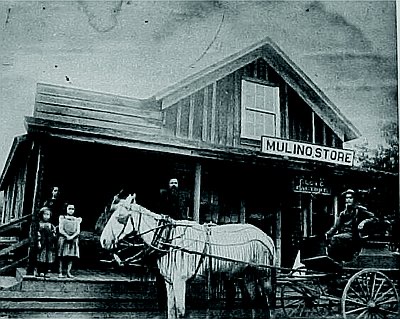
History of Mulino
MULINO
By: Richard Bland
Mulino is a hamlet of about two thousand people that began as a family enterprise and grew into a thriving community. Located in the Willamette Valley about fifteen miles south of Oregon City, Mulino was established by emigrants who had traveled west on the Oregon Trail. The original flour mill (also called a gristmill), built in 1851, may be the oldest continuously used industrial structure still standing in Oregon.
Before resettlement, the area around Mulino had been occupied by the Molala and Kalapuya peoples, who called the creek Nazzic Cu-Nazzic (Squawking Duck Creek). Introduced disease, particularly malaria and smallpox, reduced the Native population, and most of those who remained were removed to the Grand Ronde Reservation in 1856.
Most Oregon Trail emigrants who arrived in Oregon City in the 1840s set off to the south, into the fertile Willamette Valley. They traveled along a road (now Highway 213) that crossed Milk Creek, and it was there in 1845 that Richard Howard arrived from Ohio with his wife and children. Having worked as a miller, Howard saw the potential for a mill at the crossing. By 1851, he had claimed 640 acres of land under the Donation Land Act, where he built a home, a gristmill, a sawmill, and a storage barn. Both the storage barn and the gristmill, which is listed on the National Register of Historic Places, still stand. Other immigrants began to settle near the community, then known as Howards Mill.
A dam was built on Milk Creek and a sluiceway was constructed to power the mills. The waterwheel for the gristmill was powered perpendicularly; that is, the wheel lay on its side with the water running past one side, turning the wheel horizontally. The grinding stones, ordered from New York City, sent by ship around South America’s Cape Horn, took a year to reach Howards Mill.
In 1882, Charles Howard, Richard’s son, decided to open a post office. He wanted to name it Molino, which means mill in Spanish, but postal authorities would not permit it, ostensibly because the name was too similar to Molalla, a town about six miles to the south. Apparently the name Mulino was satisfactory, however, and the post office was established at the south end of town.
In 1885, Mr. Carlisle, a Confederate soldier, built a house by the road just south of Milk Creek. Twenty years later, John and Annie Force purchased the house and remodeled it in a Victorian style. By the early twentieth century, the town of Mulino had a store, a grange hall, and a gas station, said to be the only place to buy gas between Oregon City and Silverton, about thirty miles to the south. It also has restaurants, schools, and an airport for small planes. In May 2007, the county named Mulino a hamlet, only the third such designation in the state.
Mulino Flour Mill
By: Richard Engeman
The photograph above depicts one of Oregon’s earliest flour mills, built in 1851 by Richard R. Howard on the banks of Milk Creek, a tributary of the Molalla River on the east side of the Willamette Valley. An isolated rural industry, Howard’s mill was in business for nearly a century, and is pictured here as it looked in 1920.
Richard and Cynthia Howard and their six children migrated overland to Oregon in 1846, and established a Donation Land Claim of 640 acres centered on what is today the community of Mulino. Here they built a log cabin and Richard Howard began to construct a water-powered sawmill on the creek, which he finished in 1848. Howard, who had learned the trade of milling grain when he was a young man in Maryland, then decided to add a grist mill to his properties.
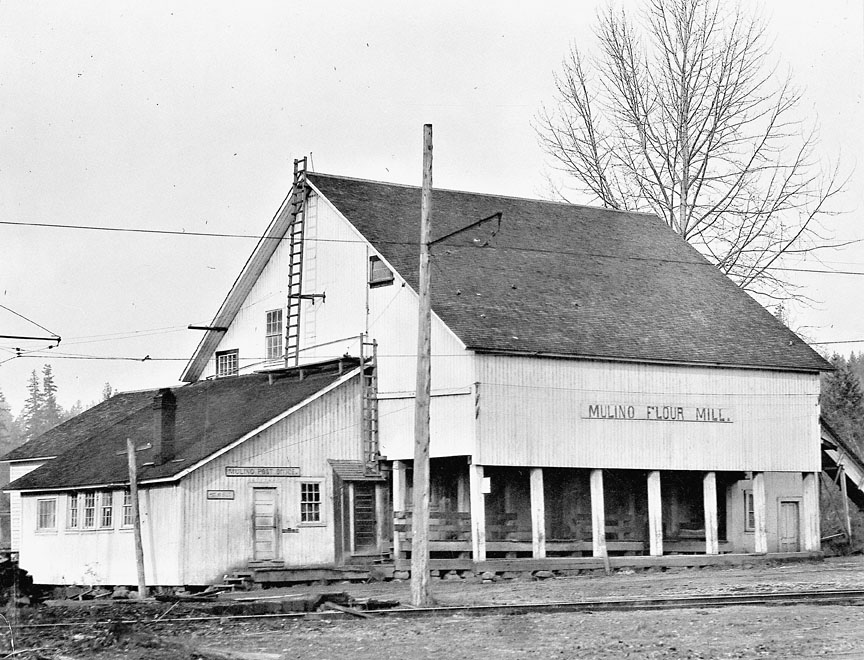
The mill was sited on the oxbow of swift-running Milk Creek. A dam was built across the creek to feed water into a fast-moving channel known as the mill race. Water in the race turned the waterwheel and provided the power to turn the burrs (millstones). The stone burrs came from New York State, sailing around Cape Horn and packed in by wagon to Mulino. The plain, rectangular mill building is framed with hew wooden posts set on a wooden sill. Several additions, similarly sided, were made about 1890, including the loading dock—with a second story supported by wooden beams—and the shed-roofed annex serving as the Mulino post office.
The grist mill’s principal task was to convert wheat to flour, and by 1851 the Willamette Valley was producing a great deal of wheat. Flour was even shipped by pack train to the gold mines of southern Oregon in the 1850s. In addition to soft wheat from nearby farms, the mill ground hard spring wheat brought in from eastern Oregon. The post office at Mulino—derived from the Spanish word for mill, molino—was established in 1888, but a railroad did not arrive until 1915, when it received a spur of the electric-powered Willamette Valley Southern Railway. Changes in agriculture—the reduced production of wheat in the Valley and the creation of large railroad- and ship-oriented traffic in wheat production and distribution—dictated a stop to milling flour in 1924, but the Howard family continued to mill poultry and dairy feeds there until 1958.
Becoming a Hamlet
Clackamas County : The Hamlet and Village Program was initiated in 2006 in response to grassroots efforts by residents to become more involved with county government and to help support their community.
While each hamlet or village has unique goals and activities, they share a common interest in retaining the flavor of their community, promoting activities to benefit the community, working with the County and outside organizations, and providing their residents increased access to (and information about) the County. Each group has a slightly different way of achieving these goals.
The structure of hamlets and villages is composed of community-elected Boards of Directors.
The citizens of Mulino voted to become a Hamlet and were recognized as such by Clackamas County in 2007.
Hamlets and Villages:
- Are voluntary grassroots organizations formed by the local community.
- Give areas a greater identity with more influence than a non-organized, unincorporated area.
- Allow for communities to decide on advisory board members, bylaws, services, activities, boundaries, and other matters.
- Have boards that are advisory to the Board of County Commissioners and are agents of Clackamas County.
- May raise funds by accepting donations and fundraising projects. Hamlets cannot request a tax levy or impose any other fees.
- With Clackamas County approval, may develop intergovernmental agreements or memoranda of understanding with neighboring communities, governmental agencies, and other entities.
CPOs
CPOs are Clackamas County’s recognized community involvement organizations that provide input to land use matters, though many take up other issues as well.
Hamlets and villages are agents of the county and are insured by the county for actions taken during hamlet or village business matters. CPOs are not insured by the county. Hamlets and villages participate in community projects, can have intergovernmental agreements with other governmental groups, conduct joint projects with other organizations, and raise funds.
Current Elected Board of Directors
The term of office for Directors, including officers, shall be two years. In even years, two (2) come up for election; in odd years, three (3) board members come up for election.
Derrick Cherico – 2025
Tracy Brody – 2025
Martha Preim – 2024
Parris Cherico – 2024
Laurel Roses – 2025
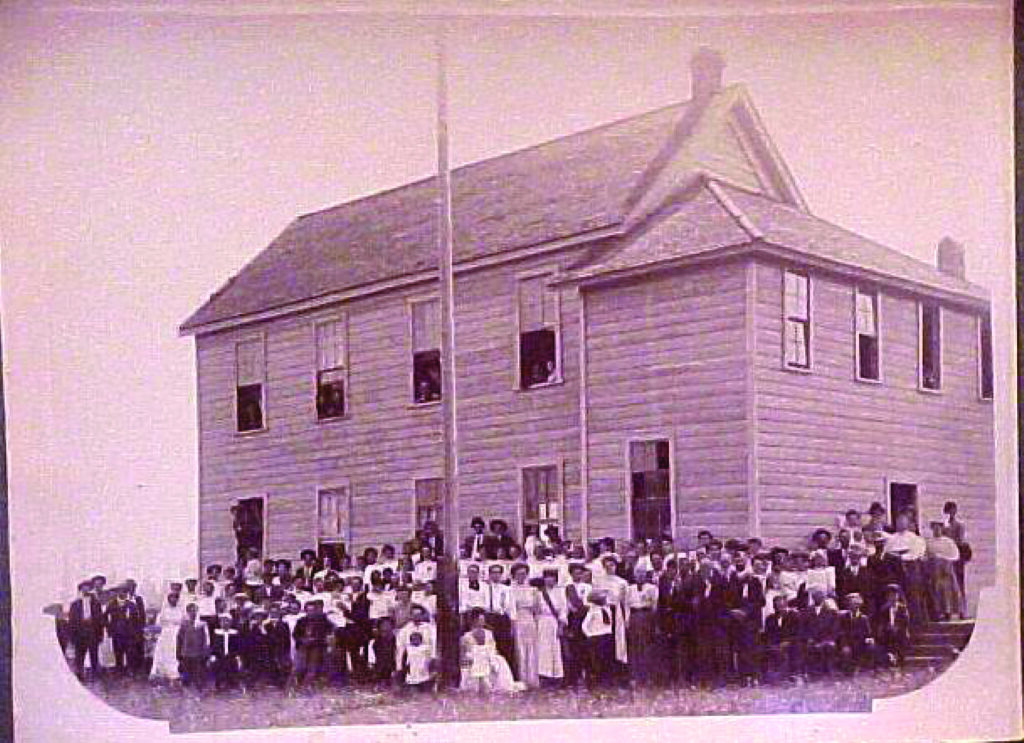
Board of Directors Applications
If you are interested in running for a position on the board and qualify as a citizen of the Hamlet, please fill out an application
Bylaws
January 2024 UPDATE, the board is still waiting for the county to send back the official copy of bylaws and boundary map.
November 2023 UPDATE, The board reviewed and approved the County’s edits. Chair Derrick Cherico re-submitted them to the county for final county approval.
September 23, 2023 UPDATE: Our bylaws changes were sent to the legal department at the BCC for Review. They sent back edits for our final review at the October meeting.
The Board of Directors approved the bylaws revisions and have submitted them to the county for review and pending approval.
Our Bylaws are currently under review and the Revision will be voted on at the Hamlet meeting on April 20, 2023.
